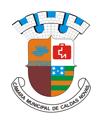Caldas Novas
| Caldas Novas | |||
|---|---|---|---|
| coat of arms | flag | ||
| cards | |||
|
|||
| Basic data | |||
| State : |
|
||
| Administrative structure : | Midwest | ||
| State : |
|
||
| Mesoregion : | South Goiás (1989-2017) | ||
| Microregion : | Meia Ponte (1989-2017) | ||
| Neighboring municipalities: | Morrinhos , Marzagão , Piracanjuba , Corumbaíba , Rio Quente , Ipameri , Santa Cruz de Goiás , Pires do Rio | ||
| Distance to Goiânia : | 156 km | ||
| Geographic location : | 17 ° 45 ′ S , 48 ° 38 ′ W | ||
| Time zone : |
UTC -3 summer : UTC-2 |
||
| Area : | 1,590.0 km² | ||
| Residents : | 70,473 (2010) | ||
| Population density : | 44.3 inhabitants / km² | ||
| Height : | 686 m | ||
| Post code (CEP): | 75000-000 | ||
| Telephone code : | +55 64 | ||
| Gross domestic product : | R $ 505 million (2007) | ||
| GDP per capita: | R $ 8,126 (2007) | ||
| City administration address: | Prefeitura Municipal de Caldas Novas PAv. Orcalino Santos, 283 Caldas Novas GO 75690-000 |
||
| Official website: | caldasnovas.go.gov.br | ||
Caldas Novas , officially Portuguese Município de Caldas Novas , is a municipality and city in Brazil in the south of the state of Goiás . The city is known nationwide for its thermal springs , which have been turned into baths and amusement parks. The main source arises at temperatures around 58 ° C in the urban area in the "Lagoa Quente de Caldas Novas". An essential branch of the city's economy is the steadily growing tourism, which has created numerous hotels, clubs and bars in the last decade.
Geographical location
The city is located at an altitude of 686 meters and 172 km south of Goiânia. The mean annual temperature is 21 ° C.
history
The region was first explored by Bartolomeu Bueno da Silva in 1722 and was part of the São Paulo captaincy at a time when Brazil was still a Portuguese colony. Originally the area belonged to Santa Cruz de Goiás, a little further north . The first settlers soon realized that the hot springs could be of great therapeutic value. In 1777, Martinho Coelho Siqueira established a permanent settlement for the development and further investigation of the region. He discovered other thermal springs on the banks of the Rio Pirapetinga and the Corrego Lavras, which from now on were called Caldas Novas, "new hot springs".
In the following years, his son Antônio Coelho de Siqueira continued the administration of the Fazenda das Caldas (Fazenda port .: agricultural property ). In 1818 he received a visit from Augusto de Saint Hilaire, the then governor of Goias, and General Fernando Delgado Leite de Castilho, who cured their rheumatism in the thermal water of the fazenda. As a result, the thermal springs became more popular. In 1838 he asked the director of the medical school in Rio de Janeiro, Dr. Vicente Moretti Foggia for an investigation into the therapeutic benefits of thermal water.
After Antônio Coelho's death in 1848, the Fazenda das Caldas and all its sources were sold to Domingos José Ribeiro, who on January 27, 1850 donated part of the Fazenda for the construction of the Igreja de Nossa Senhora do Desterro church . Senhora do Desterro became the patron saint of the city. The settlement around the church was raised to a parish from 1853 and José Olinta da Silva took office as the first pastor of the parish. In 1857 he replaced the naming of the patron saint in Nossa Senhora das Dores de Caldas Novas.
In the following period the community was continuously expanded until in 1880 the officer Cândido Gonzaga de Menezes split off Caldas Novas from Santa Cruz and merged the neighboring community of Vila Bela de Morrinhos with Caldas Novas. Officially, Caldas Novas was raised to the município (self-governing municipality) on July 5, 1911, and to the Vila (administrative unit) category on October 21, 1911. Finally, Caldas Novas received city rights on July 21, 1923.
Demographics
- Total population 2010: 70,473, estimated on July 1, 2018: 89,087
- Total area 2010: 1590 km², area 2018: 1,608.439 km²
- Population density: 44.3 inhabitants / km²
- HDI (Human Development Index) 0.802; the city ranks 10th out of 242 within the state of Goias and 533 out of 5507 nationally.
Source: IBGE
economy
In 2005 the exchange rate of the real against the euro rose sharply and was 3.6 BRL / EUR in January 2005 and 2.8 BRL / EUR in January 2006. Data from 2005 in thousand BRL:
- Agricultural Products - 24,857
- Industry - 185,925
- Services - 262,189
- Taxes - 32,492
- PIB - 505.463
agricultural area: 79,324 hectares
- permanent sowing area 114 hectares
- temporary sowing area 17,634 hectares
- natural pasture area 40,770 hectares
- natural forest area 16,851 hectares
Agricultural products (2006 figures in ha)
- Banana growing 20
- Coconut 10
- Orange 200
- Lime 15
- Cotton 120
- Rice sat. 4200
- Grain 3600
- Soy 15,600
- Millet 1200
Source: IGBE
See also
Web links
- Citizen portal of the city prefecture
- City Council website
- Caldas Novas - História. In: cidades.ibge.gov.br. IBGE
- www.brasilescola.com/
- www.uol.com.br
Individual evidence
- ↑ First results of the 2010 census in Goiás (PDF; 29 kB), carried out by IBGE .
- ↑ Caldas Novas - Panorama. In: cidades.ibge.gov.br. IBGE , accessed August 2, 2019 (Brazilian Portuguese).
- ^ IGBE . Instituto Brasileiro de Geografia e Estatística. Retrieved February 6, 2019.



